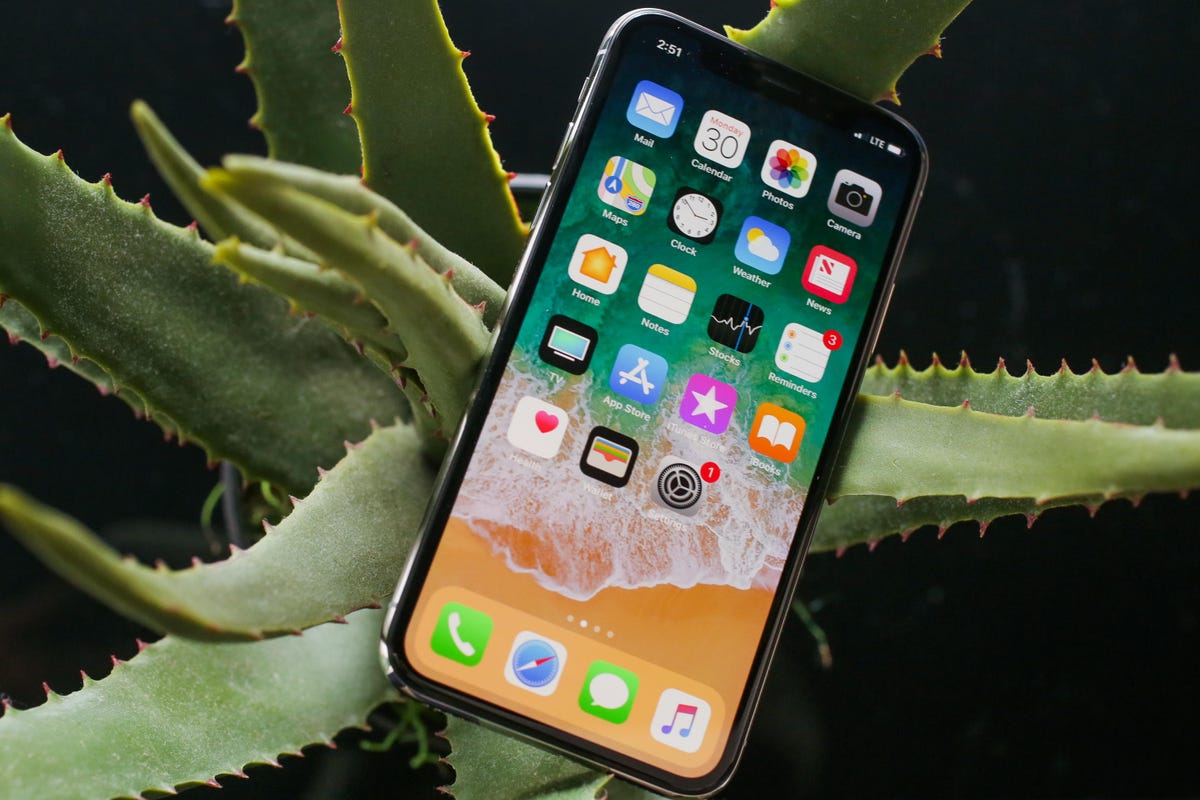
The iPhone X, Apple's most high-end and expensive phone yet, has standout looks, with a notched, edge-to-edge display and no home button.
For more info, read CNET's iPhone X review.
The iPhone X (center) leads a trio of new iPhones, flanked by the iPhone 8 (left) and iPhone 8 Plus (right). Aramis, Athos and Porthos?
Though the iPhone X is physically smaller than the iPhone 8 Plus, its near bezel-less display lends it a bigger, 5.8-inch screen.
This is Apple's first iPhone with an OLED display. One caveat with the screen is the large blacked-out notch that sits on top of the display. It's where the phone's cameras and sensors live.
Response to the notch has been mixed; while some don't mind it (like CNET's own Scott Stein, for example), others consider it an eyesore.
The 5.8-inch screen (and notch) displaying the CNET website.
Another look at the display with the weather app.
The glass back features a vertical dual camera.
Due to the glass, the back of the iPhone X is very reflective. Here, a ceiling's chandelier reflects back on the surface.
The phone measures 5.7 by 2.8 by 0.3 inches (144 by 71 by 7.7 mm) and weighs 6.14 ounces (174 grams).
The right edge of the phone.
The bottom edge houses dual audio speakers and a Lightning port for charging and file transfers. Like previous iPhones, it does not have a headphone jack.
The phone's left edge.
A closer look at the phone's silent/ring toggle and volume rocker.
Like previous iPhones, the iPhone X is water resistant.
In addition to charging through the Lightning cable, the iPhone X allows wireless charging.
The phone has a 2,436x1,125-pixel resolution with a pixel density of 458ppi.
Another look at the iPhone X's HDR display.
Comparing the iPhone X's display colors (bottom) with the iPhone 8 Plus (top). Note the Plus has a slightly larger effective display for this video, due to the X's notch.
Powering the device is Apple's proprietary A11 Bionic processor.
The 64-bit processor has an M11 motion coprocessor and a neural engine to execute AI-related algorithms.
New to the iPhone is Face ID, which uses facial recognition software to verify your face to unlock the phone.
You can also use Face ID for the digital payment system Apple Pay, purchase music and movies on iTunes and autofill forms in the Safari browser.
Setting up Face ID.
To begin, you'll need to move your face at different angles.
Face ID can register some changes to your face, like this funky pair of glasses.
It won't register every change, however. If you decide to grow a huge mustache, for example, Face ID may not work.
On the back of the phone are two 12-megapixel cameras.
The dual-camera setup features OIS, 4K video recording and includes a wide-angle and telephoto lens.
The iPhone X still has Live Photos, which are short "moving" pictures that loop.
The front has a 7-megapixel camera with 1080p HD video recording.
With the front-facing camera, you can take Portrait photos with different lighting tools.
Here, a dramatic Stage Lighting mode is selected.
A selfie with the Stage Lighting mode applied.
The front-facing camera can also apply facial filters.
Here, a Sketchbook filter is applied.
The front camera lets you send out animated emojis, or "animojis," stickers that move with your facial expression.
Another look at the animoji feature.
The iPhone X runs Apple's latest mobile operating system, iOS 11.
iOS 11 includes a Do Not Disturb While Driving mode, a hidden dark mode and new screenshot tools.
Another look at the iPhone X with iOS 11.
With iOS 11, the Control Center received a facelift.
Control Center now features sliders and toggles that make tinkering with your Settings easier.
Switching from app to app on iOS 11.
Another look at switching apps on iOS 11.
Apple's digital voice assistant Siri now has "cards" similar to Google Android and a type-to-Siri function.
There's also the digital payment system Apple Pay, which allows you to pay for items using a tap of your phone.
The iPhone X in its packaged box.
Here's what you get with the iPhone X: a charger, a headphone dongle, a Lightning Port pair of earbuds, stickers and the phone itself.
Apple faces stiff competition from its main Android rival, Samsung, whose Galaxy Note 8 (right) features a 6.3-inch screen, an embedded stylus and dual cameras.
Another look at the iPhone X (left) and the Note 8 (right).
Click or swipe through for more photos of the iPhone X.
Apple iPhone X
You can order the iPhone X now, which starts out at $999, £999 or AU$1,579 for 64GB. The 256GB model costs $1,149, £1,149 or AU$1,829.
For more info, check out CNET's iPhone X review.

